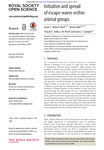Please use this identifier to cite or link to this item:
http://lib.hpu.edu.vn/handle/123456789/22430Full metadata record
| DC Field | Value | Language |
|---|---|---|
| dc.contributor.author | Herbert-Read, James E. | en_US |
| dc.contributor.author | Buhl, Jerome | en_US |
| dc.contributor.author | Hu, Feng | en_US |
| dc.date.accessioned | 2016-07-30T01:39:25Z | |
| dc.date.available | 2016-07-30T01:39:25Z | |
| dc.date.issued | 2015 | en_US |
| dc.identifier.other | HPU4160468 | en_US |
| dc.identifier.uri | https://lib.hpu.edu.vn/handle/123456789/22430 | en_US |
| dc.description.abstract | The exceptional reactivity of animal collectives to predatory attacks is thought to be owing to rapid, but local, transfer of information between group members. These groups turn together in unison and produce escape waves. However, it is not clear how escape waves are created from local interactions, nor is it understood how these patterns are shaped by natural selection. By startling schools of fish with a simulated attack in an experimental arena, we demonstrate that changes in the direction and speed by a small percentage of individuals that detect the danger initiate an escape wave. | en_US |
| dc.format.extent | 11 p. | en_US |
| dc.format.mimetype | application/pdf | en_US |
| dc.language.iso | en | en_US |
| dc.subject | Biology | en_US |
| dc.subject | Behaviour | en_US |
| dc.subject | Appliedmathematics | en_US |
| dc.subject | Evolution | en_US |
| dc.title | Initiation and spread of escape waves within animal groups | en_US |
| dc.type | Article | en_US |
| dc.size | 1.17MB | en_US |
| dc.department | Education | en_US |
| Appears in Collections: | Education | |
Files in This Item:
| File | Description | Size | Format | |
|---|---|---|---|---|
| 0351_Initiationandspreadofescapewaveswithinanimalgroups.pdf Restricted Access | 1.21 MB | Adobe PDF |  View/Open Request a copy |
Items in DSpace are protected by copyright, with all rights reserved, unless otherwise indicated.
